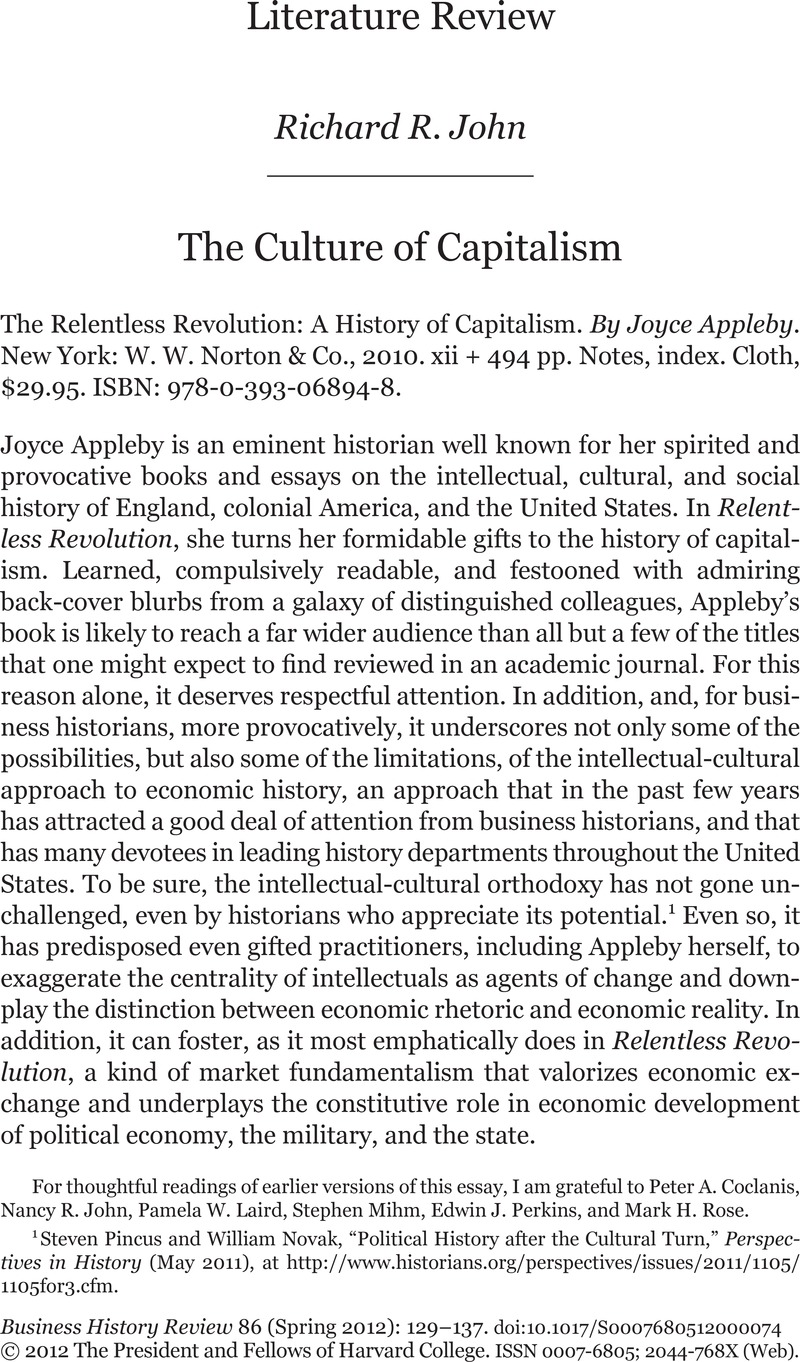No CrossRef data available.
Published online by Cambridge University Press: 28 May 2012

1 Steven Pincus and William Novak, “Political History after the Cultural Turn,” Perspectives in History (May 2011), at http://www.historians.org/perspectives/issues/2011/1105/1105for3.cfm.
2 Appleby locates the epochal shift from tradition to modernity in England in the? first half of the seventeenth century. There can be no capitalism without culture, and no “culture of capitalism” until the “principal forms of traditional society have been challenged and overcome” (p. 119). In his The Radicalism of the American Revolution (New York, 1992)Google Scholar, in contrast, Gordon S. Wood traces its origins to the United States in the late eighteenth century. Predictably, Wood's English aristocrats are less enterprising than Appleby's, and more hostile to the emerging capitalist ethos. The tradition-modernity duality that both Appleby and Wood embrace owes something to modernization theory, and is open to the familiar objections that modernization theorists have confronted for the past half-century. Was sixteenth-century England really traditional? Was the nineteenth-century United States really modern? And if so, can tradition and modernity be plotted along a single continuum?
3 The East India Company's state-guaranteed monopoly over the East Indies trade proved rather more resilient than Appleby's account might lead one to suppose. In fact, it would not be revoked until 1813, in response to the commercial challenge posed by American merchants. On this point, see Fichter, James R., So Great a Profit: How the East Indies Trade Transformed Anglo-American Capitalism (Cambridge, Mass., 2010), ch. 9CrossRefGoogle Scholar.
4 Muller, Jerry Z., Adam Smith in His Time and Ours: Designing the Decent Society (Princeton, 1993)Google Scholar; Muller, , The Mind and the Market: Capitalism in Modern European Thought (New York, 2002), chap. 3Google Scholar; McCraw, Thomas K., “The Trouble with Adam Smith,” American Scholar 61 (Summer 1992): 353–73Google Scholar.
5 Brewer, John, Sinews of Power: War, Money, and the English State, 1688–1783 (New York, 1988)Google Scholar; Pincus, Steven C. A., 1688: The First Modern Revolution (New Haven, 2009), ch. 12Google Scholar.
6 Edling, Max M., A Revolution in Favor of Government: Origins of the U.S. Constitution and the Making of the American State (New York, 2008)Google Scholar.
7 Phillips-Fein, Kim, Invisible Hands: The Businessman's Crusade against the New Deal (New York, 2009)Google Scholar; Wall, Wendy L., Inventing the “American Way”: The Politics of Consensus from the New Deal to the Civil Rights Movement (New York, 2007)Google Scholar; Fones-Wolf, Elizabeth A., Selling Free Enterprise: The Business Assault on Labor and Liberalism, 1945–60 (Urbana, 1994)Google Scholar.
8 Bensel, Richard Franklin, The Political Economy of Industrialization, 1877–1900 (Cambridge, U.K., 2000)CrossRefGoogle Scholar.
9 Dunlavy, Colleen A., Politics and Industrialization: Early Railroads in the United States and Prussia (Princeton, 1994)Google Scholar.